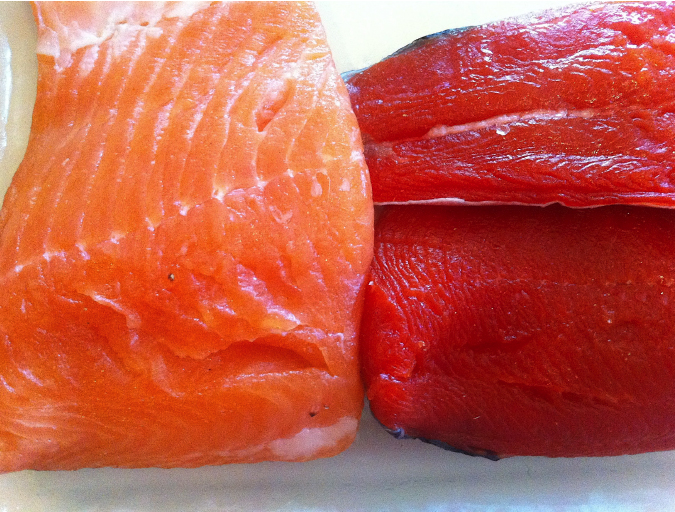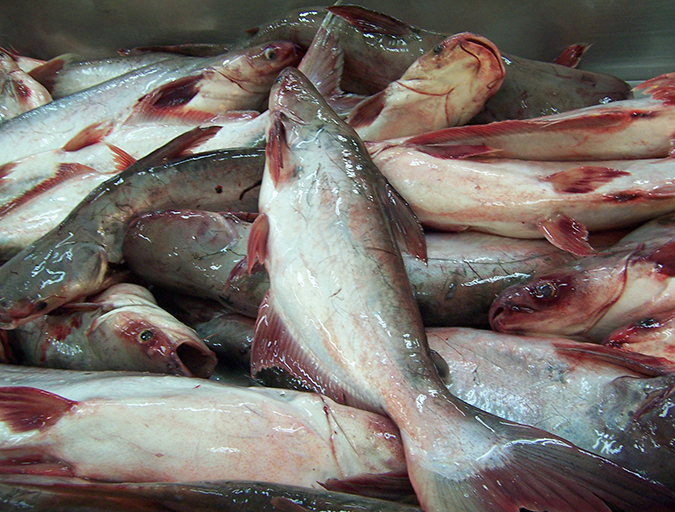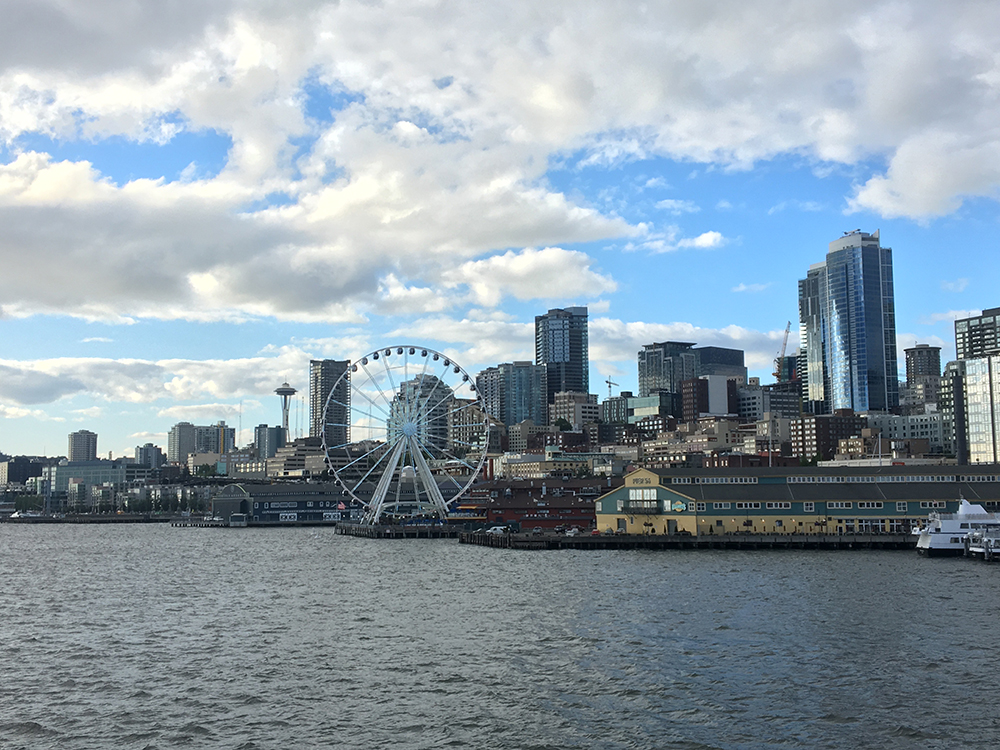Farmed fish advocates turn Seafood Expo North America conference into quasi-town meeting

Consumers may accept aquaculture as it exists right now, Scott Nichols said last week during a panel-and-audience discussion at Seafood Expo North America in Boston. But there is no embrace, he concluded, as farm-raised seafood is seen by many as more of a problem than a solution.
Nichols, a consultant and former director of Verlasso farmed salmon (a brand was forged through a partnership between AquaChile and DuPont), lamented the fact that farmed fish — the most efficient and environmentally friendly method of protein production — is not yet in good standing with the many U.S. consumers. He was in good company: His conference session “Consumer Acceptance and the Role of Aquaculture in Our Food Future” was delivered to a packed conference room at North America’s largest seafood industry trade show.
Boasting an impressive roster of expert panelists, this was not your typical lecture-and-listen conference session. With the audience seats arranged in a circle, and with the speakers standing in the middle of the room, the session took on the feel of a town meeting. Nichols stated the case for aquaculture as the most crucial protein-production solution in a world with a growing global population, limited land and fresh water resources and a rapidly changing climate that’s requiring innovation from all industries.
“It seems very hopeful that through aquaculture we can at least address an important part of our food future,” Nichols said, referring to the widespread belief that global food production must increase by an estimated 70 to 100 percent in the next three decades to meet that growing human population. “But we carry an anchor around our necks that is not very helpful.”
Citing a 2015 survey of consumers conducted by The Fishin’ Co. and the Global Aquaculture Alliance, in which 47 percent of the respondents had an unfavorable view of aquaculture, Nichols and his panelists set out to find ways to improve the perception of farmed fish in the marketplace. One panelist, the leader of a two-year-old retail seafood brand, examined what shoppers look for when they buy fish.
“How do people buy fish? They look for price first. Aquaculture wins on price,” said Jacqueline Claudia, CEO of Boulder, Colo.-based company Love the Wild. “The next thing they look for is visual appeal. We can win on visual appeal. We can win on [year-round] availability. When it gets down to it, what really matters when consumers buy fish is that it tastes good, you know where it comes from, and it’s good for you.”
It seems very hopeful that through aquaculture we can at least address an important part of our food future. But we carry an anchor around our necks that is not very helpful.
Her business, founded in 2014, manufactures retail seafood meals with trendy flavors, like Barramundi with Mango Sriracha Chutney. The Love the Wild product mix currently includes both wild and farmed fish, but Claudia told the Advocate that her company’s future product mix will be all farmed fish, mainly for the aforementioned reasons. “I’m super excited about the potential of aquaculture,” Claudia added.
Speaker Neil Sims, CEO of Kampachi Farms, has been touting the virtues of farmed fish and offshore aquaculture for years. Despite his company’s struggles with federal permitting regulations that resulted in moving its farming operations from Hawaii to Mexico, the engaging Australian entrepreneur and fisheries biologist expressed excitement and optimism that the tide is turning with consumers.
It would be a much smoother process if the the marketplace message weren’t so often and unnecessarily murky. When dining out recently, Sims said he asked a waiter about the salmon on the menu and its origins despite the word “wild” in the dish’s name. It was a farmed salmon, the waiter confessed. But it was “farmed in the wild,” he said, as if ashamed or the fact that it was indeed farmed would scare off a sale.
“What’s going on here?” Sims exclaimed. “There is this idea that nurturing the fish that we love to eat is somehow wrong. We don’t want to focus on the smear that has happened for the last however long, but people who hate on aquaculture? That’s like hating on agriculture. It’s the same thing. What’s going on?”
The three key elements that factor into consumers’ perceptions of aquaculture, Sims said alliteratively, are “people, pisces and planet.” Responsible aquaculture, he said, results in healthy animals, it provides nutritious food for people, and it is less harmful to the environment than land-based animal protein production. Aquaculture has low impacts on the environment, and a huge impact on public health, he noted.
There is this resistance to the idea of nurturing the fish that we love to eat is somehow wrong. We don’t want to focus on the smear that has happened for the last however long, but people who hate on aquaculture? That’s like hating on agriculture. It’s the same thing.
“Americans should be eating twice as much seafood that they actually are. Two servings of oily fish per week would result in a 17 percent reduction in the overall mortality rate,” said Sims. “Seventeen percent — that’s right up there with seat belts and smoking in terms of a public health imperative.”

When compared to land-based proteins, Sims was keen to point out, aquaculture rates favorably when considering land use, water use, energy use and greenhouse gas emissions. But the public at large remains focused on the industry’s past struggles, and hasn’t replaced those images in their minds with fresh ones.
Fellow panelist and successful barramundi producer Josh Goldman, CEO of Australis Aquaculture based in Turners Falls, Mass., said the future should be bright, as aquaculture is an industry of innovators. His company is an example, as it raises the Asian sea bass in Vietnam and in an indoor facility in the Northeast United States.
“Thirty years ago I built a fish tank in my dorm room because I was convinced that the trends we’re talking about in terms of resource use were going to come to a head and that the inherent biological efficiency of raising cold-blooded animals in a gravity-free environment would allow the planet to meet its food needs,” Goldman said.
In order to navigate the “headwinds” aquaculture faces, in terms of persistently negative consumer perceptions, Goldman urged the industry to “get smarter” and shift the public conservation from a defensive posture to one that’s about sharing solutions and driving innovation to build hope for what aquaculture can ultimately be.
“There’s a range innovation in feeds that have delivered vastly reduced use of marine resources, that the consumer doesn’t understand. Aquaculture is rich with innovation. We need to reframe the communications, and take these ideas and reframe out of their scientific context and into a simple and easily shared format,” Goldman said. “People love innovation, but how do we show, rather than tell?”
Final panelist Paul Raab, senior VP and partner with Linhart PR, wondered how much more fish would be sold if the industry wasn’t facing the headwinds Goldman referred to.
“Aquaculture has made enormous progress in the last 10 years, in addressing the issues that created the perception issues in the first place. But perception issues remain,” Raab said. “You need more and better data on consumer perceptions. You, as an industry, need a strong, unified voice for aquaculture. There are tremendous individual brands telling the story of sustainability, traceability and delicious taste. There isn’t a strong, unified voice to tell the aquaculture story.”
Now that you've reached the end of the article ...
… please consider supporting GSA’s mission to advance responsible seafood practices through education, advocacy and third-party assurances. The Advocate aims to document the evolution of responsible seafood practices and share the expansive knowledge of our vast network of contributors.
By becoming a Global Seafood Alliance member, you’re ensuring that all of the pre-competitive work we do through member benefits, resources and events can continue. Individual membership costs just $50 a year.
Not a GSA member? Join us.
Author
-

James Wright
Editorial Manager
Global Aquaculture Alliance
Portsmouth, NH, USA
Related Posts

Intelligence
Consumer survey explores farmed, wild seafood perceptions
What do shoppers really think about farmed and wild seafood? Commissioned by The Fishin’ Co. and the Global Aquaculture Alliance, an extensive survey conducted earlier this year sought to determine the key drivers in consumers’ seafood purchasing habits and their perception of aquaculture.

Intelligence
Risk v. hazard: A dispassionate look at pangasius
Vietnam’s pangasius industry captivated the global seafood industry, environmental organizations and the mass media. A scientific look at harmful substances detected in exported fillets and the reporting of the associated health risks through the media finds wide disparities.

Intelligence
Surmounting the consumer disconnect on farmed seafood
In his first piece for the Advocate, industry veteran Phil Walsh, VP of Growth for Alfa Gamma Seafood Group in Miami, wonders why consumers are so comfortable with farm-raised land animals, but not farm-raised fish.

Responsibility
SeaWeb Seafood Summit blog
The SeaWeb Seafood Summit, held June 5-7 in Seattle, Wash., convenes seafood industry executives, non-governmental organizations (NGOs) and ocean advocates from all over the world.


